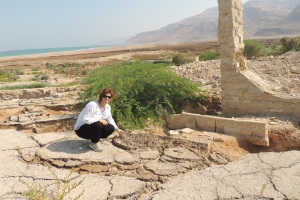 One might assume that the pictures in this blog were taken in Aleppo or in Beirut during the Lebanese Civil war. They were not. These pictures were taken on August the 23rd, 2015 in Ghor Mazraa, Jordan Valley.
One might assume that the pictures in this blog were taken in Aleppo or in Beirut during the Lebanese Civil war. They were not. These pictures were taken on August the 23rd, 2015 in Ghor Mazraa, Jordan Valley.
What was once part of a thriving agricultural community with well-paved well- lit roads, surrounded by banana fields, and a factory that employed the residents of the community is now reduced to nothing.
The ruins of the Numera factory, the devastated roads and the broken electricity poles stand witness to nature’s revenge after withstanding years of abuse. The land now is of no monetary or agricultural value and the future of the local community looks grim.
The Sinkholes phenomenon appeared in the 90s in Jordan according to EcoPeace’s Community Coordinator in South Ghor Fathi  Alhweimel. The waters of the Dead Sea began receding due to excessive damming of the sea’s tributaries, mainly, the Jordan River. Potash, Bromine and Magnesium factories on both sides of the sea have also played a significant role in accelerating the shrinkage of the Dead Sea. Fresh water from the surrounding mountains melts the salt particles, creating sink holes that are 20 to 30 meters deep. Several incidents were reported on the Jordanian side where farmers, animals or vehicles found themselves in the middle of a sinkhole.
Alhweimel. The waters of the Dead Sea began receding due to excessive damming of the sea’s tributaries, mainly, the Jordan River. Potash, Bromine and Magnesium factories on both sides of the sea have also played a significant role in accelerating the shrinkage of the Dead Sea. Fresh water from the surrounding mountains melts the salt particles, creating sink holes that are 20 to 30 meters deep. Several incidents were reported on the Jordanian side where farmers, animals or vehicles found themselves in the middle of a sinkhole.
Governments believe that the Red-Dead Canal project will save the Dead Sea. EcoPeace, however, argues that the project is not feasible and environmentally threatening. To illustrate, the impact of pumping vast quantities of seawater out of the Gulf of Aqaba on the fragile coral reefs in this area is not clear. Construction of the proposed 110 mile water and water conveyance  afterwards will have an unknown impact on the natural landscape of the Arava Valley. Threat posed by gypsum and other microorganism growth from the mixing of Red Sea and Dead Sea waters is not addressed. Solutions for silt and potential leakage of water during transport are not presented. Most importantly is the fact that mixing the Red Sea with Dead Sea waters could irreversibly alter the latter’s unique characteristics damaging its health benefits; which is the major drive for tourism.
afterwards will have an unknown impact on the natural landscape of the Arava Valley. Threat posed by gypsum and other microorganism growth from the mixing of Red Sea and Dead Sea waters is not addressed. Solutions for silt and potential leakage of water during transport are not presented. Most importantly is the fact that mixing the Red Sea with Dead Sea waters could irreversibly alter the latter’s unique characteristics damaging its health benefits; which is the major drive for tourism.
 In addition to the aforementioned problems, actual implementation of the project requires many years and the problem of the sinkholes is urgent and needs immediate attention. Therefore, EcoPeace Middle East proposes an alternative solution that is feasible with no environmental threats, i.e., the rehabilitation of the Lower Jordan River, the main tributary of the Dead Sea and an already natural conveyor. A rehabilitated Jordan River will set a model for river rehabilitation, stabilize the Dead Sea thus solving the problem of the sinkholes promising in turn economic growth, and regional stability.
In addition to the aforementioned problems, actual implementation of the project requires many years and the problem of the sinkholes is urgent and needs immediate attention. Therefore, EcoPeace Middle East proposes an alternative solution that is feasible with no environmental threats, i.e., the rehabilitation of the Lower Jordan River, the main tributary of the Dead Sea and an already natural conveyor. A rehabilitated Jordan River will set a model for river rehabilitation, stabilize the Dead Sea thus solving the problem of the sinkholes promising in turn economic growth, and regional stability.
Albums for sinkholes in Jordan/ Israel
Pictures taken by Samar M. Salma and Gundi Shachal/ Community Coordinator “Tamar Regional Council”
This post is contributed by Samar M. Salma, Media & PR officer at EcoPeace Middle East
Media Department/ Amman